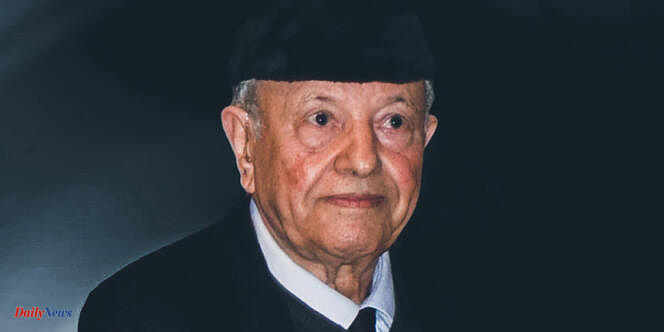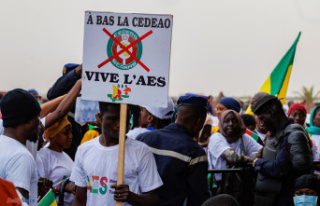He was recognizable by his eternal tarbouche, the headgear popularized by King Mohammed V and which the Moroccan independence movement had made a symbol of the fight against the French occupier. In white, black or gray felt, sometimes surrounded by a fur chapka, Mohamed Bensaid Aït Idder's headdress had, for his compatriots, the value of a manifesto: that of a man who remained a resistance fighter all his life.
Died at the Rabat military hospital on Tuesday February 6 at the age of 99, Mohamed Bensaid Aït Idder had joined the ranks of the National Liberation Army (ALN) of Morocco in the mid-1950s. At the time, the thirty-year-old operates in the Agadir region, then in the Spanish enclave of Sidi Ifni, where he participates in the establishment of the southern wing of the ALN. He recruits fighters there, supervises their training, and coordinates arms deliveries with the north wing. In the meantime, the country has become independent, but the war is not over.
In the Spanish Sahara, Mohamed Bensaid Aït Idder and the ALN executives, supported by local tribes, want to do battle with General Franco's troops and succeed in the annexation of this region to Morocco. Eager not to lose control in Mauritania, where clashes are taking place, Paris decides to support Madrid, in agreement with the Moroccan government, which fears these irregular fighters over whom it has little or no control. Operation Ouragan, called Ecouvillon on the French side, was launched in 1958. The ALN was defeated in a few weeks, but the fight was not in vain: the coastal town of Tarfaya became Moroccan again and the Sahara was transformed in the following years into national cause.
Exile in Algeria
The end of the war does not mean for Mohamed Bensaid Aït Idder the end of the struggle. A member of the powerful Istiqlal, the independence party, the following year he joined a dissident group, the National Union of Popular Forces (UNFP), founded by nationalists with more progressive aims, including Mehdi Ben Barka. Alongside several executives, including Mohamed Basri and Abderrahman Youssoufi, he was arrested in 1960, falsely accused of endangering the security of the future Hassan II, then crown prince. All were pardoned by Mohammed V, but the pressure on the UNFP increased in the following months, upon the death of the sovereign.
On December 7, 1962, Mohamed Bensaid Aït Idder went to Algeria with false papers, “at the time when the first constitutional referendum was taking place in Morocco,” recalls historian Maati Monjib. A pivotal moment in the history of the kingdom which coincides with the start of a voluntary exile which will last almost twenty years.
Two years later, it was again in Algeria that Mohamed Bensaid Aït Idder learned the news of his death sentence in absentia, following a resounding trial which notably targeted UNFP executives and deputies, accused of conspiracy against the monarchy. The former military leader has not lost contact with the activist sphere in Morocco. He is trying to remotely organize the fight against his “enemy” Hassan II, newly crowned, whose authoritarian drift he continues to denounce. Alas, “we have too many leaders and not enough troops,” he will say.
Hospitalized in Switzerland in the mid-1960s, he learned French during his convalescence, then moved to Paris, where he was taught by Jacques Berque, who held the chair of social history of contemporary Islam at the Collège de France, and gets a degree in history. From France, he joined the March 23 Movement, created in 1970 in Morocco by activists, mainly students, of Marxist-Leninist persuasion. He helps find funds and he, the fqih (literate) bathed in a solid Islamic education, begins to learn the texts of the new revolutionary left. “He represented the continuity between the old national movement and us,” explains Sion Assidon, one of the movement’s founders.
Commitment to prisoners
Shortly after his return to Morocco in 1981, it was with some of them and some surviving nationalists that Mohamed Bensaid Aït Idder founded the Organization of Popular Democratic Action (OADP), while Hassan II decreed the general amnesty for political prisoners and exiles. At the end of his clandestine activities followed a life as a parliamentarian when he was elected deputy for Chtouka-Aït Baha, the stronghold where he was born, a rural region in the south wedged between Taroudant and Tiznit. The end of the decade was marked by his commitment to the convicts of Tazmamart. He calls on the authorities even in Parliament and publishes letters from detainees in the columns of Anoual, the OADP newspaper, which will trigger the wrath of the Minister of the Interior, Driss Basri. “He gave us unconditional support,” one of the prisoners, Ahmed Marzouki, would later recount.
The OADP, which never had more than two deputies, fractured at the end of the 1990s, before being diluted in the successive reconfigurations which agitated the Moroccan left. Mohamed Bensaid Aït Idder refused to join the first alternation government, led by his former traveling companion Abderrahman Youssoufi, but without ever stopping calling for a democratic transition. Although diminished, it appeared in 2011 alongside the February 20 Movement, then supported the Hirak, the popular protest which spread to the Rif in 2016, by intervening to ease the incarceration conditions of detained activists.
Mohamed Bensaid Ait Idder subsequently devoted himself to writing his memoirs. We learn, among other things, how he twice refused to kiss the hand of Hassan II. According to Driss Khrouz, the former director of the national library of Morocco, his death marks the disappearance of “the last great Moroccan nationalist”. Declaring himself "united to the revolution", he had always refused to marry, before changing his mind as he approached sixty. On the day of the ceremony, he appeared all smiles with a tarbouche on his head.












